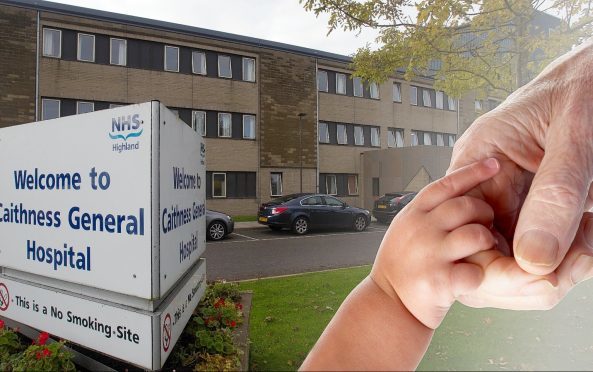Health chiefs in the Highlands have been forced to apologise after a newborn baby died.
The girl died of the e.coli sepsis infection just 40 hours after being born at Caithness General Hospital in Wick.
The tragedy in September sparked a major review, and prompted NHS Highland to lower the threshold for sending expectant mothers to the more advanced paediatric facilities at Raigmore Hospital in Inverness.
And now, a new report has revealed the details of the tragic circumstances of the baby’s death for the first time – and acknowledges that a different plan or delivery of care could have prevented the incident.
Eight recommendations have been made in the Significant Adverse Event Review (SAER) report, and health bosses will also be apologising to the girl’s family.
The baby was described as being “floppy” and having difficulty breathing when she was born, and was later making a “grunting” noise while having difficulty feeding.
Neonatal care at Caithness General Hospital is provided by the midwifery team, in contact with staff at Raigmore Hospital in Inverness.
Caithness General does not have alternative staff with neonatal training, and the report found that this led to a delay in IV access, provision of IV fluids, IV dextrose and IV antibiotics.
The external review group, from NHS Borders, concluded that it would “never be possible to say whether earlier antibiotic treatment would have altered the eventual outcome”, but it added that “this possibility can’t be ruled out”.
The report continued: “It would appear that the midwives in Caithness and the medical staff in Raigmore involved in the care were conscientiously considering the best way forward and trying to make the most appropriate plan.
“With the benefit of hindsight however antibiotics, in accordance with guidelines, could have been started anywhere up to 26 hours prior to the time of the first dose, and more reasonably perhaps 16 hours before.”
NHS Highland has already implemented some of the recommendations in full or in part.
Medical director Dr Rod Harvey said: “This extremely sad case had a devastating outcome for the family concerned. We are determined to do all we can to ensure that something like it does not happen again.
“Some deficiencies in the overall process of care were identified and a series of measures have been identified to minimise or prevent as far as possible a similar tragedy recurring.
“We are determined to embrace these measures in full and have already made a number of changes.”
Steps will also be taken to minimise the chances of an infant requiring neonatal paediatric support being delivered at Caithness General.
NHS Highland has put in place interim measures – including a temporary restriction on deliveries undertaken there – until a decision on the final configuration of maternity services there is made.
Efforts are also being made to improve the detection and management of unwell new-born babies at the hospital.
The report called for further information regarding the safety of neonatal care at Caithness General.
A public health-led review of the service, supported by expertise external to NHS Highland, will be undertaken to inform the future configuration of maternity services at the hospital.
Dr Jean Turner, chief executive of Scotland Patients Association, said: “This is a terrible tragedy.
“They need to really figure out what kind of safe maternity services they can provide at Wick. It is a very long journey from Wick to Inverness.
“The important thing is communication and being able to be aware that somebody like a young baby is ill, and being able to get the right kind of help very quickly.
“This is very sad and it won’t bring the child back.
“It may or may not have been able to have been avoided. You can’t bring babies back but you can try to make sure that all that could be done was done and it won’t happen again.”
The SAER report has been shared with the family concerned.
Recommendations made in the report
- There should be an active statement recognising that this is an extremely sad case, and with a clearly devastating outcome for the family.
- Steps are taken to minimise the probability that an infant requiring neonatal paediatric support is delivered in Caithness General Hospital.
- Steps are taken to improve the detection of and management of the unwell neonate in Caithness General Hospital.
- Develop multi-disciplinary education and training matrix for all key clinicians in Caithness General Hospital.
- Develop a mutually agreed “escalation of concerns plan” to be utilised if there is doubt about opinion or advice.
- All contacts regarding any neonates must be direct from midwife to paediatric consultant or when available, advanced neonatal nurse practitioner.
- A public health-led review of the safety of the neonatal care service, supported by expertise external to NHS Highland, must be undertaken to inform the future configuration of maternity services in Caithness General Hospital.
- A formal apology should be made to the family and ongoing communication and support should be made available to them.










